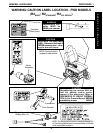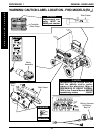
13
TROUBLESHOOTING PROCEDURE 2
T
R
O
U
B
L
E
S
H
O
O
T
I
N
G
WARNING
ONLY use distilled water when topping off
the battery cells.
Most batteries are not sold with instructions.
However, warnings are frequently noted
on the cell caps. Read them carefully.
1. Remove the battery box(es). Refer to one (1) of the fol-
lowing:
FWD WHEELCHAIRS -
INSTALLING/REMOVING
BATTERY BOXES in PROCEDURE 13 of this
manual.
MWD WHEELCHAIRS -
INSTALLING/REMOVING
BATTERY BOXES in PROCEDURE 14 of this manual.
2. Remove the battery caps from the battery.
3. Squeeze the air from the hydrometer.
4. Place the hydrometer into a battery cell.
NOTE: DO NOT fill hydrometer more than 3/4 full.
5. Draw up sufficient acid to cover float balls.
6. Tap lightly to remove air bubbles.
7. Number of floating balls indicates charge.
Number of Floating Balls
0 Discharged
1 25% Charged
2 50% Charged
3 75% Charged
4 100% Charged
* 5 Overcharged
* Check charging system.
8. Flush the liquid back into the same cell after reading the
float. Repeat this step until all cells have been properly
read. A shorted or dead cell can be detected when it is
the only cell that does not charge.
FIGURE 2 - USING A HYDROMETER TO
CHECK BATTERY CELLS (LEAD ACID)
Number of Floating
Balls Will Vary
According to Charge
9. Flush hydrometer in cold running water by allowing
the water to rise into hydrometer as far as possible.
Do this several times to guard against burn damage.
10. Replace the battery caps.
11. Reinstall battery boxes. Refer to one (1) of the follow-
ing:
FWD WHEELCHAIRS -
INSTALLING/REMOVING
BATTERY BOXES in PROCEDURE 13 of this
manual.
MWD WHEELCHAIRS -
INSTALLING/REMOVING
BATTERY BOXES in PROCEDURE 14 of this manual.
MOTOR TESTING (FIGURE 3)
1. On the 4-pin motor connector, locate the two (2) con-
tacts in the red and black housings.
2. Set the digital multimeter to measure ohms (Ω).
3. Measure the resistance between the two (2) motor
contacts.
NOTE: A normal reading is between 1 and 5 ohms
(
Ω
). A reading of 0 ohms (
Ω
) or in excess of 15 ohms
(
Ω
) indicates a problem. High readings are generally
caused by bad connections and/or damaged brushes.
Contact authorized dealer or Invacare.
FIGURE 3 - MOTOR TESTING
Motor Connector
Ohmmeter


















